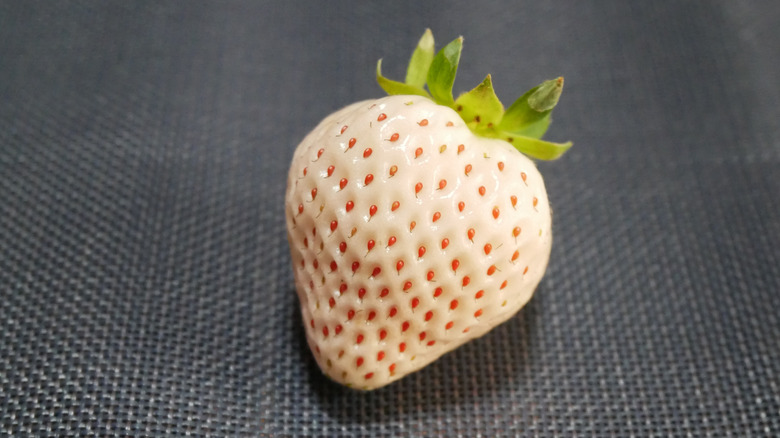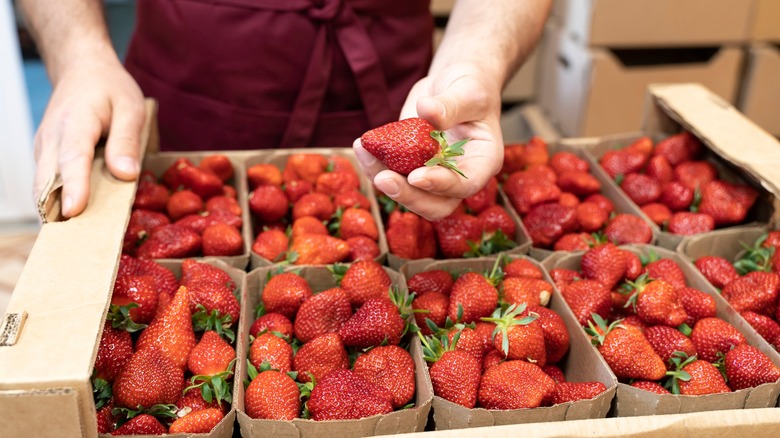The Rare Chilean White Strawberry You Should Thank
Eating is an act of all five senses, and as critical as taste and smell are to the dining experience, it is most often our sight that leads the way. We are inevitably drawn to foods that dazzle our eyes, especially when they have a unique look. But oftentimes, the most visually arresting foods are not those that appear wholly new to us, but rather those that look common...almost. Foods that blend the familiar with something unexpected, like yellow watermelons or blue tomatoes, appeal to our sense of curiosity, while comforting us with the idea that we probably know what we'd be getting into if we took a bite. There may be no better example of this than the white strawberries of Chile, or frutilla blanca, as they are known in their homeland.
Picture a common strawberry — red with pale, almost white seeds speckling the surface. Now invert the colors. Imagine a strawberry drained of its color, but all across its skin are seeds whose vivid red hue rivals the skin of its familiar kin. Frutilla blanca are slightly smaller than garden strawberries (that's the common variety that nearly all of us associate with the word strawberry), but identical in shape. They are delectably sweet, with a strong aroma that carries a hint of pineapple. White strawberries are extremely rare, but you don't need to try one to experience their influence in your life. You see, without frutilla blanca, the garden strawberries we love so dearly wouldn't even exist.
White strawberries have quite a history
White strawberries are endemic to the Nahuelbuta mountains in southern Chile. Though it doesn't have the same name recognition as Chile's more notable mountain range, the Andes, the Nahuelbuta is actually an older formation, and is home to a number of rare plants and animals that you won't find anywhere else on Earth. This region is part of the historic homeland of the Mapuche people, the largest indigenous group in South America, and we have them to thank for white strawberries (and, as you'll see, the common ones, as well). The Mapuche were the first to cultivate these berries, which they named kelleñ, and they were used for many purposes. They were certainly eaten fresh, as berries most often are, but the Mapuche also dried the white strawberries in a similar fashion to raisins, and incorporated them in a version of chicha, an ancient fermented beverage.
When Spanish conquistadors invaded South America, they became quite taken with these dazzling white strawberries. Legends say that the Spaniards were drawn to the berries' powerful aroma and become entranced by their appearance. Distracted by the resplendent fruit, the soldiers wouldn't see the Mapuche sneaking up for an attack.
When the Spaniards ultimately took over the region, they continued to propagate white strawberries, and in 1614, a Jesuit missionary named Alonso de Ovalle bestowed on the fruit its scientific name: Fragaria chiloensis. One century later, another European got his hands on the white strawberries and made a revolutionary impact on the culinary world.
White strawberries gave birth to today's common variety
In 1712, Louis XIV, King of France, sought information about Spain's military forces in Chile. He sent a spy by the name of Amedée François Frézier on a reconnaissance mission, posing as a merchant. When Frézier was not occupied by espionage, he eagerly explored the region, charting maps and taking notes of local flora and fauna. When he came across white strawberries, he was fascinated. It just so happened that Louis XIV was a huge fan of European strawberries and Frézier subsequently brought five white strawberry plants back to France, but he encountered a problem. The plants bore no fruit.
Frézier had brought only female strawberry plants back with him, failing to consider that a male plant was also needed to produce fruit. Nevertheless, he kept the plant around, and in 1766, a bright teenager named Antoine Nicolas Duchesne ultimately had the idea to crossbreed Frésier's imports with another American strawberry: Fragaria virginiana. The result was the garden strawberry that you see today in every supermarket.
As a fascinating aside, Amedée Frézier had another tie to strawberries. In 916, an ancestor of his gifted a particularly stunning basket of European strawberries to the French King, who bestowed upon the giver a new surname — Fraise — which later morphed into Frézier. As francophiles know, fraise is the French word for strawberry. Who could've predicted he'd truly live up to the name?


